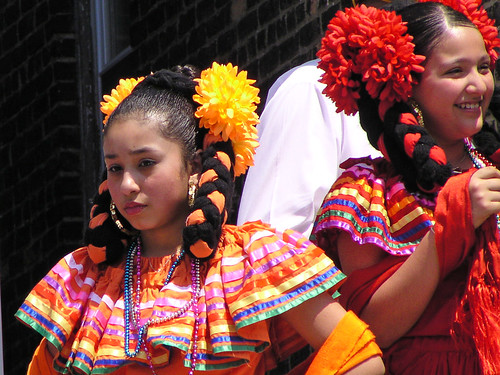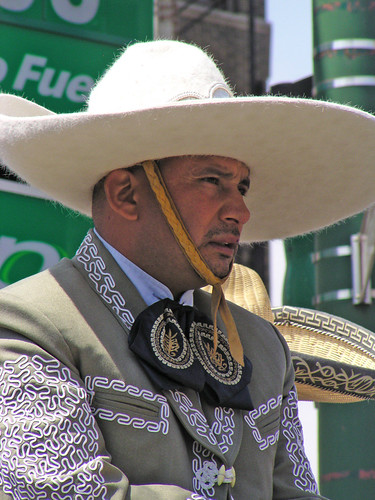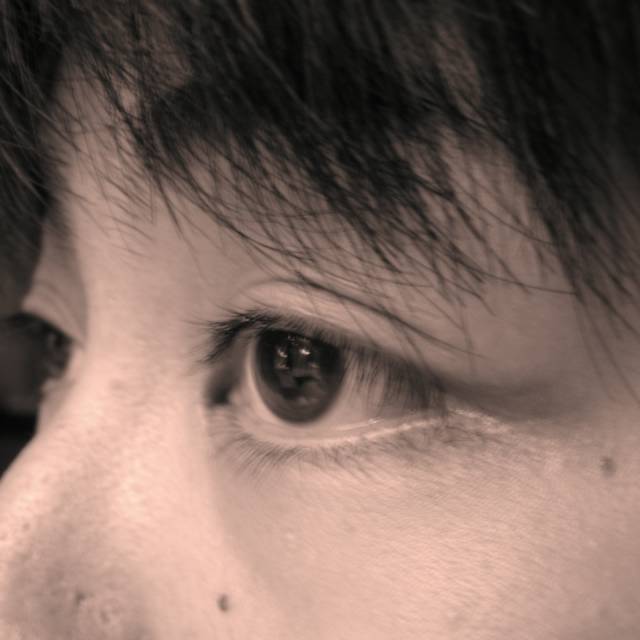vivid display, blasting music, and silent crowd--Cinco de Mayo parade in Chicago
Here are several pictures I took at the annual Cinco de Mayo parade yesterday. I found a different kind of joy in photographing people, and made a vow to visit more festivals to explore this field.

These girls fascinated me with the totally opposite facial expressions.

He was one of the charros (Mexican cowboys) on horseback. His stern gaze was complimented with his elaborate attire of traditional charros.
It was the first day of summer this year in Chicago. I felt the sun reddening the back of my neck as I stood up from the crouching position I assumed to enhance the height of the Mexican horsemen whom I was photographing. One of them had a parrot of Caribbean blue and bright yellow on his arm. Another took generous gobbles from a tequila bottle, adding to his merry mood. From time to time, some made their horses do a playful dance with a tag at the braided leather rein, clinking its silver fittings. Their traditional charro attire, which consisted of a straw sombrelo with its back defiantly bent upward, a cowboy suit with elaborate embroidery of organic motifs, a matching bow tie, and a pair of similarly embroidered boots with pointed toes, absolutely fascinated me. Partly because of the squinted eyes under the bursting sunshine, some of them had stern expressions on their faces, as if they had been on horseback in the arid desert of northern Mexico, not in the Amoco gas station in Chicago, waiting for the belated Cinco de Mayo parade to start.
From the starting point of the parade, a subtle waves of restlessness was transmitted through the air. The engines of the cars and motorcycles started to be heard, and so did the blasting boom boxes mounted on the "floats," some hauled by a gasping passenger car, others by trucks shamelessly displaying the sponsors' names from Insurance One to Miller Genuine Draft (which boasted two mestizo babes in gold-trimmed black sombrelos). With increasing dust in the air, the parade arrived. Several different kinds of military marching bands (and their high-school imitators) led the way, their perfunctory steps slightly betraying the spotless helmets and perfect creases. On the following floats, teenage girls in vivid traditional dresses waved hands, with occasional flips and flaps of their skirts, leaving momentary curved traces in the back of our eyes. Children in straw hats and thick woven capes waved hands on another.
A Tribune reporter approached me and asked several questions. As I gave her answers, almost automatically geared for a "good appearance on paper," a bad habit of a perpetual student, I noted her Gucci sunglasses. (She actually used my comment in her article the following day, starting it by this passage: "By many accounts, Chicago's Cinco de Mayo parade can't touch festivities in Mexico. But celebrators say Chicago is tops in one aspect: the diversity of the crowd.")
Several more floats passed by, followed by a team of Latin American motorcyclists all dressed in embroidered black leather jackets, and two dozen classic cars and lowered, tilted, bouncing cars of all sorts, and the parade came to an abrupt end. A few police officers and two street-cleaning car concluded the parade. The crowd, which seemed to be quite composed throughout the 15-minutes procession of the parade, started to disperse. With all its blasting Latin tunes and vibrant colors of their traditional outfits, there was a sense of falseness, or hollowness to the parade, as is (too) often the case with the traditional ceremony anywhere in a "developed" countries. With a few tequila-induced exceptions, people were far from the top of excitement. Cries of mandatory "Viva Mexico!" from the floats were not matched by the replies from the crowd. It is probably only natural, that the Mexican Americans, uprooted from their native land and culture, even if voluntarily, feel detached from the celebration of the independence of their native country. The tradition and the culture celebrated on the occasion were no longer truly a part of their lives. Still, the non-responsiveness of the spectators, ironically accentuated by the lively displays of the marchers, was somewhat saddening as yet another sign of our alienation from our own cultural heritages.



0 Comments:
Post a Comment
<< Home